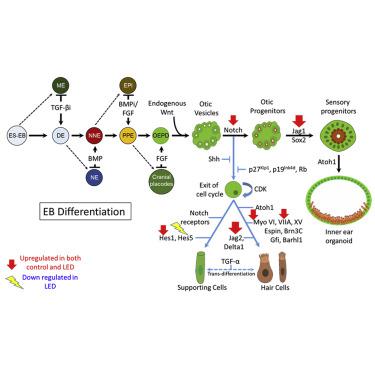Molecular Therapy - Methods & Clinical Development ( IF 4.6 ) Pub Date : 2020-03-13 , DOI: 10.1016/j.omtm.2020.03.010 So-Young Chang , Nathaniel T. Carpena , Seyoung Mun , Jae Yun Jung , Phil-Sang Chung , Hosup Shim , Kyudong Han , Jin-Chul Ahn , Min Young Lee

|
Photobiomodulation (PBM) stimulates different types of stem cells to migrate, proliferate, and differentiate in vitro and in vivo. However, little is known about the effects of PBM on the differentiation of embryonic stem cells (ESCs) toward the otic lineage. Only a few reports have documented the in vitro differentiation of ESCs into inner-ear hair cells (HCs) due to the complexity of HCs compared with other target cell types. In this study, we determined the optimal condition to differentiate the ESCs into the otic organoid using different culture techniques and PBM parameters. The efficiency of organoid formation within the embryoid body (EB) was dependent on the cell density of the hanging drop. PBM, using 630 nm wavelength light-emitting diodes (LEDs), further improved the differentiation of inner-ear hair cell-like cells coupled with reactive oxygen species (ROS) overexpression. Transcriptome analysis showed the factors that are responsible for the effect of PBM in the formation of otic organoids, notably, the downregulation of neural development-associated genes and the hairy and enhancer of split 5 (Hes5) gene, which inhibits the differentiation of prosensory cells to hair cells. These data enrich the current differentiation protocols for generating inner-ear hair cells.
中文翻译:

通过光生物调节增强的小鼠胚胎干细胞的内耳类器官形成。
光生物调节(PBM)在体外和体内刺激不同类型的干细胞迁移,增殖和分化。但是,关于PBM对胚胎干细胞(ESC)向耳代谱系分化的影响知之甚少。仅有少数报告记录了体外与其他靶细胞类型相比,由于HC的复杂性,ESC分化为内耳毛细胞(HC)。在这项研究中,我们确定了使用不同的培养技术和PBM参数将ESC分化为耳类器官的最佳条件。类胚体(EB)中类器官形成的效率取决于悬滴的细胞密度。使用630 nm波长的发光二极管(LED)的PBM进一步改善了内耳毛细胞样细胞的分化以及活性氧(ROS)的过度表达。转录组分析显示了导致PBM在耳类器官形成过程中起作用的因素,尤其是神经发育相关基因的下调以及5号分裂的毛状和增强子(Hes5)基因,可抑制感觉细胞向毛细胞的分化。这些数据丰富了用于生成内耳毛细胞的当前分化方案。











































 京公网安备 11010802027423号
京公网安备 11010802027423号